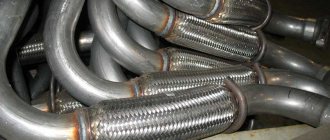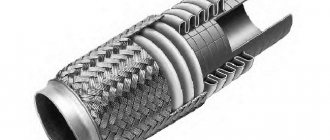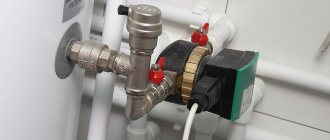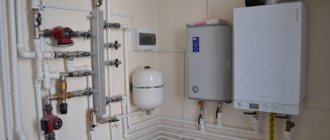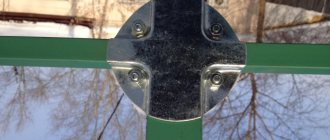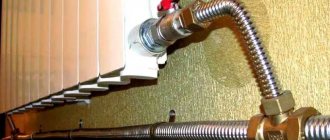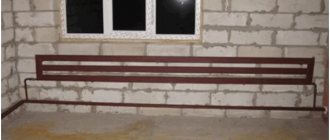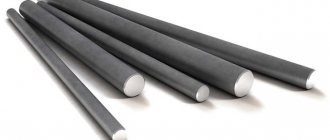Stainless steel corrugated pipes for heating are a relatively new product with wide distribution prospects. They are adapted for operation at elevated temperatures and a wide range of operating pressures. Installation is carried out without the use of special equipment. The products bend at almost any angle, without narrowing the duct.
Corrugated metal pipes are suitable for installing hot water supply and heating systems
Scope of application
Structures with a folded system are widely used in such areas as:
- rainwater drainage system;
- disposal of municipal and industrial wastewater;
- drainage assembly;
- heating and water supply system;
- supply of water to apartments under pressure;
- gas supply inside buildings;
- plumbing model of corrugation for the sewer system;
- pipeline for fuels and lubricants;
- ventilation system;
- connection of air conditioners;
- sheath protecting the electrical cable;
- "warm floor" system.
It is worth taking a closer look at the options for using corrugated pipes.
- For laying cables. Folded pipes are needed for laying electrical, television, computer, and telephone cables in the domestic and industrial spheres. The corrugation guarantees a high degree of protection from weather conditions, mechanical stress, and also serves as a dielectric layer. PVC pipes are most often used, because they are easy to transport and store, they do not require welding, and are installed without grounding. Polyvinyl chloride is not flammable and is used to protect electrical wiring. Both low-current and power cables can be installed in folded pipes.
- In construction and the housing and communal services system. Corrugated pipes are widely used in the construction of residential and industrial premises for the installation of communications. Corrugation is used for cold and hot water supply, in heating systems, and gas supply to houses. In apartments, it is extremely easy to connect a folded pipe from the hood to the ventilation shaft. It can be used in virtually all rooms, mounted into walls or used externally.
- For sewers. Sewer pipes must be designed to withstand heavy loads. Some types of corrugation cope well with this task; they are laid underground and are resistant to corrosion, mechanical stress and frost. Their good performance qualities allow you to avoid repair work for many years, but technical inspection of pipes is recommended to be carried out annually. To combat congestion, chemical cleaning methods are used or hydrodynamic cleaning is used, when steam or water is loaded into the system under high pressure, which allows clearing congestion. For sewerage, rigid types of corrugations of large diameters are used.
- Drainage system. Drainage corrugated pipe is made from PVC for carrying water supply from various objects. In everyday life, such corrugation is of little use, as it softens at temperatures above +65 degrees. It is better to use products made of polyethylene (PE) or polypropylene (PP).
- Warm floor. The “warm floor” system is suitable for the excellent characteristics of stainless steel corrugation: high heat transfer, reduced linear expansion, temperature capabilities. For floor equipment, pipes with diameters of 12 and 15 mm, 50–60 meters in length, are used.
Corrugated pipes are a frequent guest in houses and apartments. Their light weight and simple assembly allow many owners to install these products themselves. When purchasing a corrugation, fittings are included. To connect them to a mixer or tap, gaskets made of rubber or polymers are used. Before use, it is necessary to loosen the fitting nut on the side of the intended fastening. The pipe can be cut using a roller pipe cutter or any cutting tool. The cut should be processed, removing burrs and achieving smoothness.
The corrugation must be carefully straightened, giving it the required shape. At the next stage, the pipe is connected to the fitting until it stops and is fixed with a union nut, in this case you can use a wrench, but do not be too zealous to prevent failure
The nut is firmly pressed into the ribs of the corrugation. The pipe is attached to the surface using plastic brackets secured with nails. Upon completion of work, the structure should be tested under water pressure. If leaks are detected, the fitting nuts will have to be tightened. Installation of corrugated pipes is much faster than working with any other materials.
Stainless steel corrugated pipe price
| Name | Diameter | Wholesale price |
| Corrugated stainless steel pipe 15 mm | 15 mm | 400 rubles / kg |
| Corrugated stainless steel pipe 20 mm | 20 mm | 400 rubles / kg |
| Corrugated stainless steel pipe 25 mm | 25 mm | 400 rubles / kg |
| Corrugated stainless steel pipe 30 mm | 30 mm | 400 rubles / kg |
| Corrugated stainless steel pipe 32 mm | 32 mm | 400 rubles / kg |
Copper pipes
Copper pipes are available in two versions: annealed and unannealed. The latter variety is produced by processing ore into ingots of almost 100% frequency. During the pipe rolling process, the material significantly loses its elasticity, but at the same time gains strength. The internal structure of the metal remains at the same level.
Annealed pipe is produced using a similar technology, but the final stage of processing involves exposure to high temperatures. After complete cooling, the material begins to exhibit the required properties.
Annealed copper pipe
The differences between annealed and unannealed copper pipe are only in operational characteristics. Both types are used when creating a heating system, water supply channel and air conditioner. Copper has important properties - thermal conductivity, bactericidal properties, corrosion resistance, which makes the material optimal for the manufacture of household pipes.
In the modern production of annealed and unannealed pipes, polymer coating technology is used, which is aimed at reducing heat loss
This is important for products that will subsequently become part of the hot water supply and heating system. In addition, condensation does not form on the surface
Copper products are characterized by smooth internal walls, so the formation of scale and clogging of the diameter is practically impossible throughout the entire period of use. Copper pipes can withstand high temperatures well, so even thin walls can withstand sufficient loads.
Annealed pipes have improved technical characteristics; a special composition is used for manufacturing. The result is a product that becomes resistant to UV radiation and chemical attack. Also, an annealed copper pipe does not deform when the liquid in it freezes.
What product shortcomings should we not forget?
- The downside is the high price - this is a controversial issue, since the material itself is not cheap, plus a unique manufacturing technology. The low price of such a thing should alert you, most likely it is a fake. When making a purchase, check the integrity of the packaging - there are markings on it, there are no inscriptions on the pipe.
- Another feature manifests itself during operation and saddens housewives: dust accumulates in the depressions of the pipe, which is difficult to wash out.
- The products are afraid of external mechanical damage; special screens will provide protection.
- The disadvantages of the connections include the fact that the fittings require regular maintenance.
- If part of the heating system is located in an open room, additional insulation is required to avoid heat loss.
- Twisting is not allowed.
- There is a possibility of corrosion caused by electrochemical processes (grounding saves).
Specifications
Durable and high-quality pipes are necessary for the installation of gas and water supply systems. Products must have a long service life, as well as resistance to various factors destructive to the material.
An important characteristic is also the specificity of installation, connection and fastening
The main distinctive characteristics of steel products of this type are flexibility combined with high strength indicators. Such positive features are inherent in all corrugated steel pipes, regardless of the size, weight and diameter of the product. Due to these properties, installation of communications is greatly facilitated and the service life of the product is increased.
The production of stainless steel corrugated pipes began in Japan. Having appreciated the advantages of such products, they began to produce similar products all over the world. Leading positions in the list of manufacturers today are occupied by South Korean companies. For the manufacture of pipes in accordance with GOST, high-quality stainless steel is used, regardless of the type of product. Some products undergo additional heat treatment, due to which the product becomes softer, which means that the annealed pipe will bend better.
Such products are in demand for arranging sections of communication routes with complex configurations, where there are various turns and bends. However, the products are highly expensive, due to which, when laying direct pipelines, their use will be irrational. For such work, unannealed corrugated pipe is used; the difference in price for these products, in comparison with annealed ones, will be noticeable, especially when installing long-distance systems.
Based on its design features, a corrugated metal pipe is a structure that, due to cross sections of different sizes, has the ability to bend without the risk of loss of integrity. Raw materials for manufacturing are selected based on certain proportions of alloying components, among which it is worth highlighting carbon, chromium and nickel. This composition provides the product with unique corrosion resistance properties.
The manufacturing technology of flexible pipes consists of the following steps:
- A stainless steel strip is formed into a pipe.
- The resulting product is welded on special equipment at a heating temperature of about 1150°C.
- Quality control of the formed seam. Monitoring is carried out by applying pressure to the product in a liquid environment.
- Giving the product a corrugated appearance is carried out by exposing the workpiece to shafts of different sizes.
- To increase the flexibility of the pipe, it must be heat treated.
- The finished product must be cut into pieces of the required length using a special tool.
- The last stage is to roll them into coils for further transportation.
Corrugated stainless pipes can be classified based on reliability and recommended load level
Taking into account the reliability of corrugated pipes, it is worth noting that they come in different degrees of strength:
- Single-layer, which is characterized by minimal weight and maximum flexibility. Similar products are recommended for laying water pipes, for use as a shell for gas supply and various electrical wiring.
- Double-layer pipes have additional reinforcement. This configuration allows the product to be used in areas where there is a risk of damage to communications. The specificity of the products, resistance to aggressive chemical environments and mechanical stress, allow the pipes to be used in the construction of high-pressure water sewerage systems, where high pipe capacity is required.
Based on resistance to loads, products can be divided into the following groups:
- Light category pipes. Such products are recommended for installation in external structures, since they do not have a high load resistance.
- Corrugated pipes of the heavy category - products are allowed for underground installation, for example, for water supply. Pipes have an average resistance rating.
- Extra-heavy pipes - their use is possible in systems with a high level of load on the products.
Key Features
Corrugated stainless steel products have a number of advantages over polymer and conventional metal analogues. Among them: long service life, high strength and reliability, as well as ease of installation. It is especially convenient to use them to create flexible heating lines.
Various versions of the products in question are produced. The corrugation can have a diameter of 32, 25, 2 and 15 millimeters. It is technically possible to create products of other sizes, but only the above products are mass-produced.
The key advantage of corrugation is the ability to perform its function in different temperature conditions. Such pipes can withstand frost down to -50 degrees. Therefore, they can be used to transport liquid nitrogen and other low-temperature substances. The upper temperature limit is +110 degrees. This limit is limited by the properties of the fittings used, which contain components made of plastic. The steel corrugation itself can withstand heat up to +800 degrees.
Another advantage of corrugated pipes is their resistance to pressure changes. The products are capable of functioning properly at a maximum level of ten atmospheres. However, there are varieties of products that can withstand pressures of up to sixty atmospheres.
The service life of stainless steel corrugations is twenty years. With careful operation in accordance with technical requirements, this period can be much longer.
Installation of fittings
To work with stainless steel pipes, in addition to fittings, you will need a set of tools:
- pipe cutter - without it it is difficult to evenly cut a corrugated pipe, and the reliability of the future assembly depends on the accuracy of the cut;
- installation tool corresponding to the type of connection of the fitting: welding machine for welded shaped elements, a tightening or regular adjustable wrench for crimping, press pliers for crimping;
- knife - it is necessary if the pipes are covered with a protective film.
Having prepared the necessary tools, perform the work in the following order:
- The necessary measurements are taken and the corrugated pipes are cut into pieces of the required length with a small margin.
- Clean and polish the cut. If there is a protective film, cut it 1-2 cm from the edge.
- Clean and degrease the fitting and its auxiliary parts.
- If a welded fitting is used, install it flush with the end of the pipe, fix and solder it, making sure that there are no distortions. This completes the execution of the unit; all that remains is to connect the elements of the pipe network in the same way to the remaining branch pipes of the fitting.
- When using crimp and press fittings, you must first remove the fixing elements: the crimp nut or press ring.
- A nut or ring is placed on the end of the pipe and moved along the pipe from the edge a few centimeters.
- If the corrugation does not have its own retaining ring, insert such a ring into the end of the pipe so that its cut rests against the stopper.
- Remove the sealing ring gasket from the fitting and put it on the pipe so that the edges of the retaining ring and spacer ring coincide.
- Install the fitting body close to the cut of the corrugated hose and move the fixing element towards the body.
- Complete the fixation. If using a compression fitting, tighten the compression nut until it contacts the body. If a press fitting is used, press the ring using press pliers.
We recommend that you read: Pressure pipes for communications made of polyethylene - characteristics and scope of use
Some manufacturers produce crimp and press fittings in kits that do not require disassembly - this is usually indicated in the product instructions. For such shaped elements, it is enough to loosen the nut by unscrewing it ⅔ of the length of the threaded pipe, or move the press ring the same distance from the body. Then a section of pipe is inserted into the undisassembled fitting until it stops, after which the fixing part is returned to its place where it is crimped or crimped.
Corrugated polyethylene pipes
Polyethylene corrugated pipes have many advantages, which explains their great popularity and widespread use in various fields. Products made of polyethylene easily withstand the negative effects of the environment. Therefore, they are often used to construct a drainage system. Also, products made from this material easily tolerate mechanical loads and evenly distribute loads throughout the pipeline.
Polyethylene pipes are widely used for laying electrical cables. Products with a small cross-section ensure the reliability of cables. This is explained by the fact that the material is low-flammable, which minimizes the possibility of a fire.
Pipes with large diameters are ideal for constructing drainage, sewer and water supply systems. The outer surface of the material is made of corrugated low-density polyethylene. The coating can have different colors and easily withstands ultraviolet rays. The inner walls of the pipe are made of high-density polyethylene and have a smooth surface. Thanks to this, the liquid moves freely through the pipeline, and the risk of blockages is minimized.
Basically, low-pressure polyethylene pipes are used outdoors, and high-pressure polyethylene pipes are used inside buildings. Among the advantages of such products it is worth highlighting:
- Resistance to corrosive processes. The products are inert to stray currents and active ions.
- High resistance to chemicals. Thus, the products are not afraid of such aggressive liquids as gasoline, oil, solvents and others.
- Elimination of plaque formation on the walls. Due to the fact that the inner walls have a smooth surface, plaque does not form in the pipe. This eliminates clogging and a decrease in the internal diameter of the pipeline.
- Resistance to various mechanical damages. Corrugated pipes have a corrugated shell, which increases their resistance to stress.
- Light weight material. Polyethylene products are lightweight, which greatly simplifies their transportation and installation. There is no need to use special equipment when laying pipes.
- Affordable price.
The main disadvantage of polyethylene is the instability of the material to ultraviolet rays, which reduce its performance properties. Therefore, when laying outdoors, care should be taken to protect the pipeline from direct sunlight.
Disadvantages of stainless corrugated pipes
There are no products without flaws on the market. Even such high-quality products as corrugated pipe, made from an expensive alloy using rather complex technology, are not without drawbacks. Perhaps it is worth talking not so much about the shortcomings as about the features of using high-tech products. What must be taken into account when working with stainless corrugated pipes for the heating system:
- high cost. Stainless steel corrugation cannot be cheap due to the complexity of manufacturing and the high cost of raw materials;
- the tendency to accumulate dust in recesses, which reduces heat transfer and can affect the health of persons in contact with the products;
- high heat transfer, requiring additional insulation to avoid heat loss;
- thin walls, not designed for high mechanical loads. If necessary, a special casing is installed for protection;
- the need for periodic inspection and maintenance of fittings, monitoring the tightness of connections, replacing polymer elements;
- it is undesirable to install the system in a completely hidden form due to the presence of detachable connections in which polymer seals are used. However, this circumstance does not matter when installing a heated floor;
- desirability/necessity of protection against the effects of electrochemical corrosion.
Another feature of corrugated stainless steel deserves study, resulting from the presence of stiffening ribs that resist the passage of the flow of the working medium.
Note! Purely theoretically, a corrugated pipe should have a higher hydraulic resistance than a smooth-walled one and impart turbulence to the flow of the working fluid. However, no practical evidence has been provided that corrugated pipes, due to the described properties, cannot be used in gravity systems with a naturally circulating coolant.
The appearance of corrugated pipes in the arrangement of a heating system is unusual; to some it may seem anti-aesthetic. Note that products are produced in different colors, so there is scope for design delights. Of course, the appearance of the stainless steel corrugation can be neglected by making a hidden installation.
We install stainless steel corrugation for water supply
Corrugated pipes are easily assembled into coils
Pipe installation is carried out with the following tools: a knife for cutting copper pipes, rolling, a set of nuts and locking rings, a wrench. The procedure looks like this:
- We cut the pipe to the length between the holes that need to be connected.
- We put on the nut, followed by the retaining ring.
- Using rolling, we “bend” the sharp edges, thereby blocking the reverse movement of the nut.
- Place an O-ring on the pipe up to the nut.
- Using a wrench, connect the pipes to the water supply.
This option is the simplest, but requires the use of rolling of the same diameter as the corrugation. Moreover, not everyone may have the tool.
If you plan to connect to a fitting, the procedure will be as follows:
- We cut the required pipe size with a pipe cutter (also suitable for plastic pipes).
- Loosen the fixing nut on the fitting.
- We insert the pipe into the fitting until it stops.
- Tighten the nut.
Production technology
For the production of corrugated pipes, alloy steel is used, which includes chromium and nickel to improve the anti-corrosion properties of the material.
The production technology looks like this:
- A sheet of alloy steel is cut into a series of long strips of small width, the strips are loaded onto a separate conveyor and delivered to another workshop.
- In another workshop, the steel strip is bent on both sides. The edges of the tape are connected to each other using automatic welding. As a result, we get a standard pipe without stiffeners.
- To check the quality of welding, a special laser installation can be used, which evaluates the nature of the scattering of laser beams - this makes it possible to determine the presence of holes in the part.
- After this, the pipe is passed through a series of shafts of different diameters, which deform the original part + form stiffeners.
- At the final stage, the part is heat treated using a special machine or burner. After cooling, the part is cut into pipes of the required length.
- At the end, a final check is performed. For this purpose, the edges of the corrugated pipes are closed using special “plugs”. Then the part is placed under water for several minutes - if during this time no air bubbles form, this means that the part is completely sealed.
Laying corrugated steel pipes as boxes
There is another option for using corrugated pipes - for installing electrical wiring. They can be installed both indoors, on walls and ceilings, and outdoors (when organizing communication networks).
Boxes made of corrugated stainless tubes, used as insulation for wires, have their own positive qualities, which are significantly higher than their plastic counterparts.
They are used because:
- Stainless steel serves as excellent protection for the electrical network against fire, which makes it possible to lay cables even in environments with flammable structures.
- The flexibility of the boxes allows them to easily bend around walls and ceilings, making the installation process much easier.
- Such a box is extremely tight, preventing moisture or moisture from entering the wires. Additionally, steel protects the cable from mechanical influences that can damage the cable, as well as from rodents and other pests.
The wall thickness of corrugated pipes for boxes is regulated by the relevant building codes. These rules should be observed especially carefully when working in environments with a high fire hazard. In particular, this applies to wooden structures.
A list of requirements for wire and corrugation can be found in the corresponding tables.
When bending stainless steel corrugated pipes, the rotation angles must be normalized. In degrees, these values should be 90, 120 or 135. The bending radius also has its own standards. When laying systems in wall slabs or in the case of a vertical outlet, the radius should be 40 cm. If the cable line is laid in solid foundations, then the radius should be 80 or 100 cm.
It is worth noting that if the box intersects with a temperature or sedimentary seam, it will be necessary to provide for the placement of compensating devices in the project drawing.
The stainless steel box is fixed as a cable channel with a nominal diameter of 1.5-2 cm every 250 cm, and for channels DN 40-80 - every 350-400 cm. Clips or clamping mechanisms can be used as fasteners. Corrugated pipes for electrical wiring are not permitted to be attached to metal elements or other pipelines for process applications.
If you plan to install hidden wires with insulation in the floor, the grooves must be at least 20 mm deep. After laying the cables, the ditches must be sealed with cement mortar. Flexible boxes can be laid in grooves made in walls, concrete, and also hidden under decorative panels.
Professional workers can assemble simple units in just an hour. However, there are times when the use of corrugated steel pipe is impractical. For example, chimneys for boilers made of steel pipes with smooth walls will be safer and more efficient (read: “Types of corrugated pipes for chimneys, their characteristics and installation rules”).
What is it and where is it used?
Corrugated steel pipe is a long hollow cylinder of steel with a variable cross-section, resembling an accordion in appearance. Its uniqueness lies in the combination of the strength of metal with the flexibility of rubber.
In less than forty years of existence, the product has gained enormous popularity in construction, manufacturing and agriculture.
Corrugated stainless steel is used in the construction of the following systems:
- Heating;
- Gas supply;
- Water supply;
- Conditioning;
- Firefighting;
- Warm floor;
- Pipelines for various fuels and lubricants;
- Electrical networks - usually as a protective corrugation for cables.
Installation of fittings for corrugated pipes
The procedure consists of two main stages - preparation of the necessary equipment and installation itself.
Stage one. Preparing the necessary equipment
You should start with the fact that you must prepare tools for fixing fittings and cutting corrugated pipes. Thus, the minimum “set” should include the following tools:
- pipe cutter (it will allow you to cut pipes of this type, ensuring an even cut and maintaining the same shape);
end flaring tools; a tool with which fittings for corrugated stainless pipes will be pressed in; tightening keys (they can be replaced with a crimping device).
We also note that the installation of the plumbing system must be carried out by an experienced specialist, and during installation, a gas installation engineer must at least be present at the work site.
Stage two. Installation
Let us immediately make a reservation that the installation procedure is the same as in the case of ordinary copper or any other pipes. If, for example, a fitting with a seal is used, then the procedure looks something like this: after removing the nut, the sealing ring is checked; if everything is in order with it, then the nut is screwed back on by about one and a half to two turns. After this, the fitting is inserted into the pipe until it stops, and the nut itself is finally tightened.
To install such elements that do not have sealing parts, you must first remove the nut and remove the half-rings made of brass. Then the nut is put on the pipe, and the thread at this time should be directed towards the connecting element. The half rings are placed on the rings of the corrugated pipe (more precisely, on the first one from the edge), the nut is placed in such a way that these half rings are inside it. Finally, the nut is screwed on and tightened.
Video - How corrugated stainless steel pipes are connected
Also during installation it is necessary to adhere to a number of important requirements. Let's look at them.
- You should not use fittings for installation that may later be subject to rusting.
- The number of flexions/extensions recommended by the manufacturer should also not be exceeded - it should be kept to a minimum.
Before the brass fitting located on the supply water supply or heating pipe (if it is made of ferrous metal), it is imperative to install a water filter. It is also not recommended to expose stainless corrugated pipes to electric current (of any type). Before installation, the corrugation is checked for torsional stress. When installing pipes, care must be taken to ensure that they do not come into contact with ferrous metal, which is known to rust over time. For fixation, you need to use elements made of non-ferrous metal or plastic. If you are installing a “warm floor” system, then you need to use only whole sections of pipes. There can be no talk of any additional connections above the floor surface! Finally, before installation, it is recommended to carefully inspect the pipes to ensure that there are no visible defects (kinks, dents, etc.).
Reviews and operating experience
Corrugated metal pipe is a relatively new product. From the forums studied by household users and specialists, one thing is clear - the main complaints are increased resistance to water flow (compared to a smooth pipe) and noise. However, none of the users noted the need to install additional circulation pumps.
There are often recommendations indicating the need to check pipe connections under high-temperature operating conditions. Gaskets usually become stiff under such conditions.
As an example, here are a few real reviews:
“….I put it on both CB and IR…no problems…manufacturers also have tests here at the testing site…compared to plastics, gn (corrugated stainless steel) is better just in terms of temperature…about scale…I don’t know…the only negative is the high price… »
“The most important drawback of corrugated stainless steel in central heating risers is noise, especially in a single-pipe system, and if this is not a radiator connection, but actually a riser across several apartments, the noise is noticeable and continuous...”
“...for example, heated floors are better than metal corrugation...it can be bent several times....”
To complete the picture, a little more time needs to pass.
Some useful tips from the experience of specialists:
- Do not install a stainless pipe with a fitting that is susceptible to corrosion;
- If a fitting with a supply pipe is installed on a ferrous metal pipe, be sure to install water filters;
- In a floor heating system, installation is carried out only in whole sections, additional connections are not allowed;
- The less bending and extension, the longer the pipe lives
Corrugated stainless pipe: history of invention
An invention such as a corrugated stainless steel pipe appeared at the end of the twentieth century. Its authors are Japanese scientists who were looking for the best option for laying communications in conditions of increased seismic activity on the islands. This is how a universal product appeared, combining the flexible qualities of rubber and the strength of steel. It took world experts very little time to come to the general conclusion that flexible metal pipes have a number of advantages over their analogues made of cold-rolled sheet steel, as well as over polypropylene and metal-plastic pipes.
Flexible stainless pipes gradually replaced steel and polypropylene structures
In this regard, almost immediately after the invention of corrugated pipes, their mass production began in Germany, and then in South Korea, which is currently the leader in the production of flexible stainless steel pipes. Well-known companies involved in their production include Korean. Due to the popularity of the brand, the metal corrugation is also called a cofulso pipe. Gradually, enterprises in different countries began to specialize in the production of corrugated products, and their use became widespread in the installation of utility networks and other communications.
Characteristics of Corrugated Stainless Steel Pipe
Thus, flexible stainless pipes gradually replaced steel and polypropylene structures, as well as metal-plastic communications used in the creation of plumbing, heating, ventilation and even gas systems. The strength of the material is ensured by the fact that only high quality stainless steel with admixtures of nickel, chromium and carbon is used in the production process.
The manufactured material must comply with a certain list of characteristics that guarantee certain product quality standards, in particular:
The strength of the material is ensured by the fact that only high quality stainless steel is used in the production process
- Normal operating pressure is 10 atmospheres with a permissible maximum load of 60 atmospheres.
- During operation, a corrugated stainless steel pipe can withstand the temperature of the passing substance from 0 °C to 100 °C. In this case, the maximum limit can reach 150 °C and above.
- Pipelines for organizing construction work and individual repairs, depending on the scope of application, are produced with a diameter of 15, 20, 25, and 32 mm.
Stages of production of corrugated stainless steel pipes
The versatility and high quality performance of stainless steel corrugations are due to strict adherence to its manufacturing technology, which, surprisingly, is quite simple. The production process itself includes the following stages:
The special corrugated design provides this type of pipe with a high degree of flexibility.
- A pipe is formed using a special steel tape.
- Workpieces are cooked using tungsten electrodes. At this stage of production, special automatic TIG equipment is used. The process occurs at high temperatures, which can reach 1150 °C.
- The reliability of the seams is checked using a special laser installation.
- The corrugation is formed using special shafts of various diameters.
- Perform heat treatment of parts. Different types of pipes are susceptible to a certain degree of temperature exposure, since annealed pipe has a higher degree of flexibility.
- Products are packaged. Pipes are divided into sections of a certain length. Products with a small diameter are rolled into coils, and thick parts are packaged in groups.
- They check the quality and filter out defects in the form of products with microcracks. For this purpose, a metal corrugated pipe is placed in a liquid under high pressure. In this case, a special device is attached to each bay and the pressure is gradually increased to 10 atmospheres, then it is gradually reduced.
Popular manufacturers and prices of stainless steel pipes
As mentioned above, the leaders in the market for the production of corrugated stainless steel pipes are companies from South Korea, the most popular of which are the following:
- Kofulso is the most famous company that was at the forefront of the production of corrugated stainless steel pipes. It is this technology that is used to produce products for pipelines at other enterprises in this field. The popularity has had a corresponding impact on the cost of stainless steel and products made from it.
- Lavita. Reviews from experts and users indicate that the products of this manufacturer are characterized by a long service life, but the fittings are of less high quality. Marriage occurs with a frequency of 2-3 cases per 100 copies. It happens that when tightened, a metal ring can cut through the wall, so the products of this company are cheaper than Kofulso pipes.
- Hydrosta. The products correspond in price and quality characteristics to Lavita pipes. Users also complain about fittings that leak in every fifth case out of a hundred.
- Meibes. The company is quite new in the construction market, but has managed to establish itself well in the production of corrugated steel products. There are practically no complaints from consumers, except for the high price of the products.
Kofulso is the most famous company that was at the forefront of the production of corrugated stainless steel pipes
Speaking about manufacturers of corrugated pipes, it should be noted that this type of product has not yet been counterfeited. According to experts, this is explained by the fact that special expensive equipment is used in production, and the technology itself is quite complex. In addition, the production of stainless corrugated pipes is still at the development stage, so there is no particular excitement for the product.
Characteristics and price of corrugated stainless steel pipe “Neptune”
Speaking about manufacturers of corrugated pipes, attention should be paid to domestic ones. This is a new company on the Russian market, which presents a line of flexible corrugated stainless steel pipes, and also produces brass fittings and other components for pipeline installation.
The company's most popular product is corrugated stainless steel pipe Neptun IWS, used in the construction of a variety of engineering systems, including heating communications, hot and cold water supply, as well as in the creation of water-heated floors and fire extinguishing systems. In addition, a separate production line consists of corrugated pipes for flexible connections to gas appliances and sealed metal hoses used for laying electrical networks.
Helpful advice! It should be noted that the price of stainless pipes is relatively low; much more money is spent on consumables that are necessary during installation. In this regard, the installation of a flexible stainless steel pipeline is inferior to the installation of plastic and polypropylene pipes, since it is more expensive.
Among the domestic manufacturers of corrugated pipes, it is necessary to highlight
A young enterprise in the structure of domestic production emerged relatively recently - in 2014. Its founder was the largest manufacturer of equipment for underfloor heating and heating systems, SST Group of Companies. Neptun IWS, located in the Moscow region, is the only Russian company that produces flexible corrugated pipes. It is worth noting that they are produced exclusively from high-alloy stainless steel using modern European equipment.
Neptun IWS steel corrugated pipelines and fittings fully comply with the requirements of energy saving and environmental friendliness. The product can be easily cut and bent without changing the flow area, without the formation of microcracks or other damage to the metal.
Installation diagram of an autonomous water supply element from a corrugated pipe
Using corrugated stainless steel pipes, you can create a project for an autonomous water delivery system in a country house or in a private house. Water can be transported cold or hot, and the source can be a well or borehole.
An interesting fact is that the main task of the control unit of such a system is to automatically turn on the pump, as well as turn it off when the user stops consuming water. In winter, when water is not being used, it is drained into a source to prevent the water in the pipeline from freezing and damaging it. Water is drained from the system by opening the tap and removing the check valve. Accordingly, to activate the system, everything returns to its original position.
The list of equipment that may be required when constructing a water supply unit is determined based on the size of the site and the number of devices consuming water. Additionally, there may be a need for a water storage tank (calculated individually, depending on consumption), a manifold with outlets, and a pump without a check valve. The productivity of the latter is also determined by the level of water use. Hot water supply equipment will require a storage type heater.
To install a control unit from a corrugated pipe for heating, you will need to acquire the following tools and elements:
- flexible hose (40 cm long) along with gaskets and retaining rings;
- 1 inch check valve;
- 2 tees with 1 inch external thread;
- device for measuring liquid and gas pressure, pressure switch;
- five-way fitting;
- 1 inch tap;
- 2 American (couplings with a union nut) per 1 inch.
